My wife and I also recently traveled to Lugang (Lùgǎng / 鹿港 / often spelled “Lukang”). This is in Zhanghua (Changhua) County, not far from Taizhong. It makes a nice day trip from Taipei, especially if using the high-speed rail for transportation.
Despite this being the second photo-laden post in a row, I haven’t dropped my general love of low-bandwidth entries. These photos are in part evidence toward an important point that I think is getting overlooked in the discussions of how much it will cost Taiwan to change to Hanyu Pinyin: The signs in much of Taiwan remain inconsistent and something of a mess despite the at-best partially instituted change several years ago to Tongyong Pinyin. More on that in a later post.
Now for the signs.
Lugang, whose name means “deer harbor,” put deer signs atop some signposts.
Many of the signs in Lugang are in Tongyong Pinyin (e.g., Jhongshan and Mincyuan, for what in Hanyu Pinyin would be Zhongshan and Minquan). Note that other signs are in English — or in Chinese characters with no romanization at all. (Note, too, that the two signs for Minquan Road (民權路) — one of which is partially covered — point in different directions!)
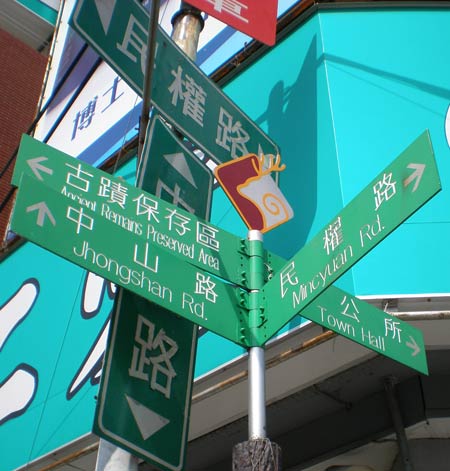
But Tongyong Pinyin certainly isn’t the only romanization system found there. Here, for example, we have Wade-Giles (“Longshan,” “Zhongshan”). (Note that there’s no romanization given for Sānmín Road / 三民路.)
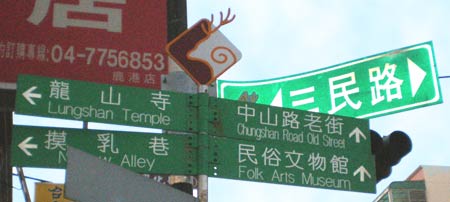
And here’s yet another romanization system on official signage within Lugang. In the photo below the top sign is in the rarely seen Gwoyeu Romatzyh: Cherng-Hwang Temple, which in Hanyu Pinyin is Chénghuáng (“city god”) Miào (城隍廟). The sign below that (“San-Shan Kuo-Wang”) is in Wade-Giles. And the two signs below that don’t have any romanization at all. None of these signs are likely very old.
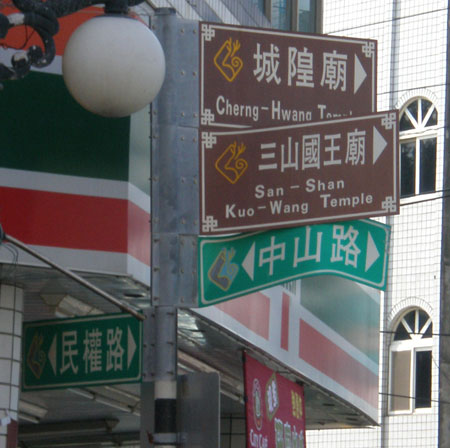

 About 150 years ago “bilingual” signage meant something very different in Taiwan than it does today. Back then it was Literary Sinitic and Manchu, as seen on this stela outside a temple in Lugang.
About 150 years ago “bilingual” signage meant something very different in Taiwan than it does today. Back then it was Literary Sinitic and Manchu, as seen on this stela outside a temple in Lugang.
While in the Lugang Folk Arts Museum I spotted a photo from the Japanese era of a building with romanization. Note, too, the “Huang” (黃) at the top, which marks the ownership of the Huang family. Many buildings in Lugang bear that mark.
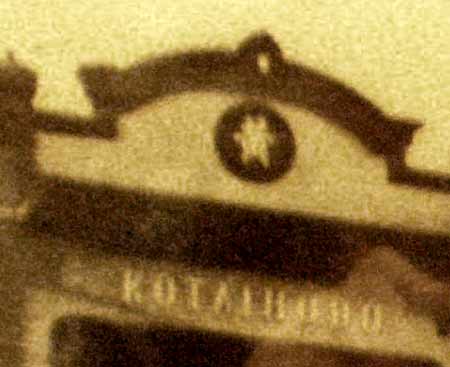
Here’s the whole building:
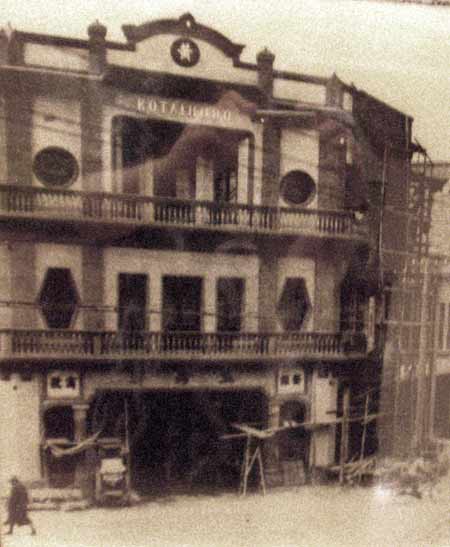
I didn’t notice that particular building while I was walking around the town. But I did see this one, with “CHIN” in large letters:

No less interesting are the letters, now largely effaced, near the top of the same building (click to enlarge). They were used to write something in Taiwanese.

After leaving Lugang, what should I see at the Taizhong high-speed rail station but InTerCaPiTaLiZation. That practice is a cancer on romanization everywhere.

I feel a little guilty because much of Lugang — at least its historic section — is lovely and worth visiting. But here I’ve been showing you a bunch of signs. If you’d like to see what Lugang looks like beyond its signs, try parts one, two, and three of Craig Ferguson’s posts on his visit there.

Many thanks.
Regarding the nearly largely effaced lettering, you wrote:
– – –
They were used to write something in Taiwanese.
– – –
The first part looks like it might be “Taiwan, Lugang,” but I can’t even guess about the remainder.
Whatever system is used, there’s something to be said for consistency, which seems to be present at least in the green signs. One set, with the white triangles, consistently has no romanization, and the other consistently has English with Wade-Giles. Only the brown signs lack any consistency.
Here in the mainland most of the use of pinyin is like this: ZHONGHUARENMINGONGHEGUO. No tones and no spaces. I guess it can help a little if you get stuck on a character and can fish through the mess to get the corresponding syllable, but you’re out of luck for the tone.
I noticed that Google’s English-Chinese dictionary also fails to give tone marks, surprisingly.
You’re gonna hate me for saying this ;) but your own use of parentheses for showing Chinese, pinyin transliteration, and English gloss is rather inconsistent; sometimes you have Chinese in them, other times pinyin with or without tone marks, sometimes using quote marks, and sometimes not. And sometimes your quote marks are facing the wrong way. OK, I’ll stop. ;D
The Manchu sign is impressive. It’s extremely well-preserved (or restored, I can’t tell which). The Manchu on the stela makes perfect sense. It’s interesting that the spacing of the Manchu words makes it look like it is following the Chinese in a word for word translation, but actually “morin” (horse) and “ebu” (dismount) are switched around so that “morin” accompanies ?? (zhìc?, at this point) and “ebu” accompanies ? (m?, horse).
Whatever system is used, there’s something to be said for consistency, which seems to be present at least in the green signs. One set, with the white triangles, consistently has no romanization
Taiwan’s street signs are supposed to have romanization. Signs without this should be replaced.
and the other consistently has English with Wade-Giles. Only the brown signs lack any consistency.
Most — but not all — of the green signs are in Tongyong Pinyin (see top photo), not Wade-Giles.
Here in the mainland most of the use of pinyin is like this: ZHONGHUARENMINGONGHEGUO. No tones and no spaces. I guess it can help a little if you get stuck on a character and can fish through the mess to get the corresponding syllable
Yeah, China’s misuse of Pinyin drives me up the wall.
but you’re out of luck for the tone.
I’ve seen tone marks on some signs in China. But that was a long time ago, and even then such signs were definitely but a tiny minority.
As for tone marks here, until just last month Taiwan’s official rules on signage explicitly banned their use. (I can recall only one instance of tone marks on official signage in Taiwan.) That restriction, however, was removed, in no small part because I noted that tone marks are needed to distinguish between some names. But I very much doubt Taiwan will be putting up many signs with tone marks. Given Taiwan’s tradition of sloppiness, perhaps the fewer ways in which to screw things up the better. (Others have debated the usefulness of tone marks.)
You’re gonna hate me for saying this ;) but your own use of parentheses for showing Chinese, pinyin transliteration, and English gloss is rather inconsistent; sometimes you have Chinese in them, other times pinyin with or without tone marks, sometimes using quote marks, and sometimes not.
Guilty as charged. It probably won’t come as a shock to anyone that I don’t particularly care about Hanzi. Accordingly, I seldom bother to include them, except to aid searches. And when writing on my blog, I tend to be a lot sloppier than in my professional work. But if I were in charge of signs here, I’d make damn sure they were correct, esp. given the amount of money being put into them.
And sometimes your quote marks are facing the wrong way.
That’s @#$! WordPress, trying to be helpful. The only way I’ve found around this is to paste in the Unicode NCRs for the open- and close-quotes marks. But I’m usually too lazy to bother.
The Manchu sign is impressive. It’s extremely well-preserved (or restored, I can’t tell which).
I thought you’d like that.
I forgot to mention that’s a modern reproduction, not the original.
The Folk Arts Museum also had some Manchu documents. But low lighting, reflections off the glass cases, etc., prevented me from getting any useful photos.
As for tone marks here, until just last month Taiwan’s official rules on signage explicitly banned their use. (I can recall only one instance of tone marks on official signage in Taiwan.) That restriction, however, was removed, in no small part because I noted that tone marks are needed to distinguish between some names.
Wow. So you actually had a measurable influence on the government?
That’s @#$! WordPress, trying to be helpful.
Actually now that you mention it, that’s happened to me too. ;)
That building is actually still there, on the main road (Zhongshan Rd, I think), near the northern end of Nine Turns Lane (from which you can see it). There’s a famous bakery in the first floor. Here’s a pic I took:
http://picasaweb.google.com/jbbreed/WestTaiwan#5138547222187821394
Wow. So you actually had a measurable influence on the government?
Every once in a while I get lucky. I’ll post details once everything’s officially ratified.
Thanks, J.B., for the photo. It looks like there’s no longer even a trace of that romanization.
Regarding the nearly largely effaced lettering, the romanization appears to be Pe?h-?e-j? (POJ) for Taiwanese Holo. Here’s what I can figure out:
Tâi-ôan Lo?k-káng Iân Sin … H?
Tâi-ôan = Taiwan
Lo?k-káng = Lukang/Lugang (old Taiwanese name: Lo?k-á-káng)
I also cannot figure out the meaning of the rest. What was the context of the building?
Pinyin Info: thanks for sharing those sign info. I would never have noticed those things myself.
I thought you might appreciate this picture of a sign in London’s Chinatown (where the street signs also have hanzi) – http://commons.wikimedia.org/wiki/File:Bilingual_sign_Chinatown_London.jpg
There’s also another one here: http://flickr.com/photos/kayodeok/120424511/ – if you also look at http://flickr.com/photos/persia2004/55279755/ and http://flickr.com/photos/linux_traveler/328083365/ you’ll see the problem.
Nice(?) to see street signs have mistakes no matter which country you’re in…
Thanks for the photos, Nikki. They prompted me to work on one of my many draft posts. Look for it in a couple of hours.
These photos were taken in Taiwan?
The Pinyin system in China mainland and in Taiwan is different. Infact in China mainland we call mandarin as “PuTongHua”(???), however in Taiwan ti is called “GuoYu”(??), I guess the word ‘mandarin’ is come form Hongkong or Taiwan, as its meaning may close to “GuoYu”.
Personally, I don’t think the Pinyin system in Taiwan (Tongyong Pinyin?) has standardized until today, therefore there are different spelling has appeared.